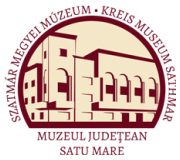Liviu, Marta - Szőcs Péter Levente (szerk.): Catalogul colecţtiei de archeologie (Satu Mare, 2007)
Istoricul colecţtiei de arheologie din Muzeul Judeţean Satu Mare
the archaeological sites from Culciu Mare, Medieşu Aurit, Ciumeşti and Berea, revealing multiple chronological layers. Sever Dumitraşcu from the Pedagogical Institute of Oradea carried out research in the area of Unimăt, Medieşu Aurit and Potău, in the 1960’s. Most of the materials discovered during these archaeological excavations were either deposited in the regional Museum of Baia Mare, or were included in the collections of the organizer researchinstitutes. The City Museum of Satu Mare was reorganized in territorial museum in 1958 while a similar museum was founded in Carei. Due to the organization of the new administrative units in 1968, the County Museum of Satu Mare was founded, comprising all museum activities in the county. Starting from this point, the discoveries made in the county remained here, in the archaeological collections of Satu Mare and Carei. Specialists in archaeology were employed during the 1960s: Tiberiu Bader at Satu Mare and János Németi at Carei, while Gheorghe Lazin and Neţa Iercoşan joined the staff later. This generation of archaeologists reorganized and enriched significantly the collections. They made systematic archaeological researches and rescued the accidental archaeological finds. The most important researches were made in the Neolithic sites from Tăşnad-Sere, the area of Homoroade, Pişcolt; the Bronze Age sites from Culciu Mare-Sub Grădini, Cehalu\-Telek, Boineşti-Cefafe, Tiream-Kendereshalom; the cemetery from the Hallstatt period in Sanislău; the Celtic cemetery from Pişcolt; the Dacian settlement from Acâş-Râtul lui Maitini; the Roman Age sites from Medieşu Aurit-Şuculeu, Lazuri-Râtul lui Bela; and the medieval castles from Crucişor-Dealul Pintii and Tămaşeni. During the 1980 s, the archaeological research of the Bronze Age tell type settlement from Carei-Bobald, was led by Petre Roman from the Romanian Institute of Trachology, Bucharest. The archaeologists made a great number of archaeological rescue excavations in the endangered sites because of the mechanization of the agriculture, the intense exploitation of sand quarries, and the sewage and drain works. A great number of pieces found accidentally were recovered in period: the coin hoards from Turulung, Ghirişa, Hot I—III; and the bronze deposits from Vetiş, Domăneşt Sărvăzel, Căpleni etc. The archaeological collection of museum increased through acquisitions, too. About 20 finds were bought from the Calvinist priest Gyula Ko’ by the museums of Baia Mare, Satu Mare and Carei. objects were collected from Berea, Ciumeşti, Foieni Sanislău, between 1961 and 1977. The archaeological research of the County of Satu IN made a significant development after the political chai of 1989. The cooperation with the Romanian Institut Trachology continued and the Institute of Archaeolog the Romanian Academy from Cluj-Napoca was co-op The cross-border relationships were established, too, main partner from Hungary being the Jósa András Musi from Nyíregyháza, and, from Ukraine, the Universit Ujgorod (Ungvár). The systematic researches were resta in the sites of Carei-Bobald, Lazuri-Lubi Tag and Med Aurit-Şuculeu. The staff of archaeologists from the County Museui Satu Mare changed gradually with young specialists ir middle of the 1990 s. The museum has reassumed to re the vestiges affected by different building-works, effort was supported by the legal framework created a end of the 1990 s, and intended to protect the endang patrimony. Therefore, the archaeologists from Satu I made rescue excavations within the modernization \ of the national road Petea-Cluj; at the building of the check-points at the borderpoint from Petea, Urziceni Halmeu; at the mounting of the gas-pipes among Haln Medieşu Aurit-Tăşnad, and of the optic fibers in the w county. The rescue excavations are carried permanent the recreational area of Tăşnad and during the buil works in the historic center of Satu Mare city. Due tc incidental discoveries, the coin hoard from Tămăşeni the bronze deposits from Pir, Giorocuta and Tiream ent the museum collection. 14
